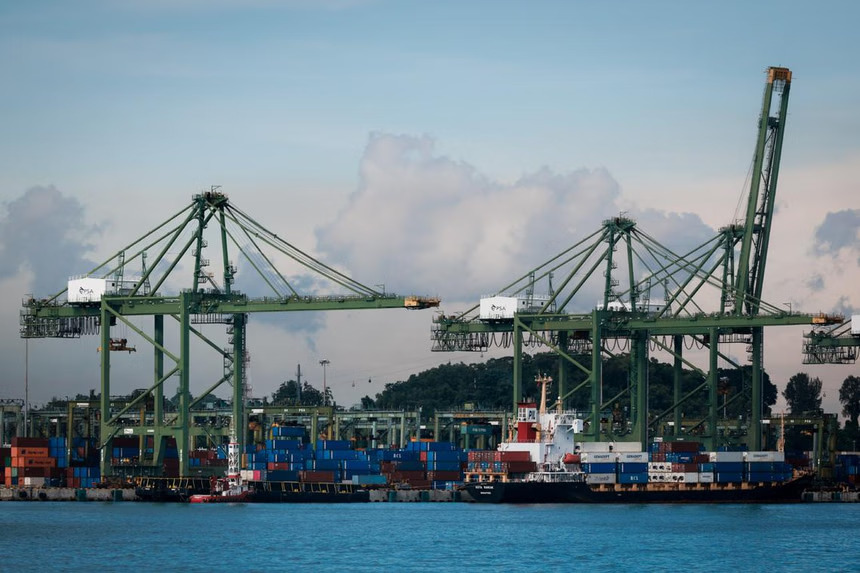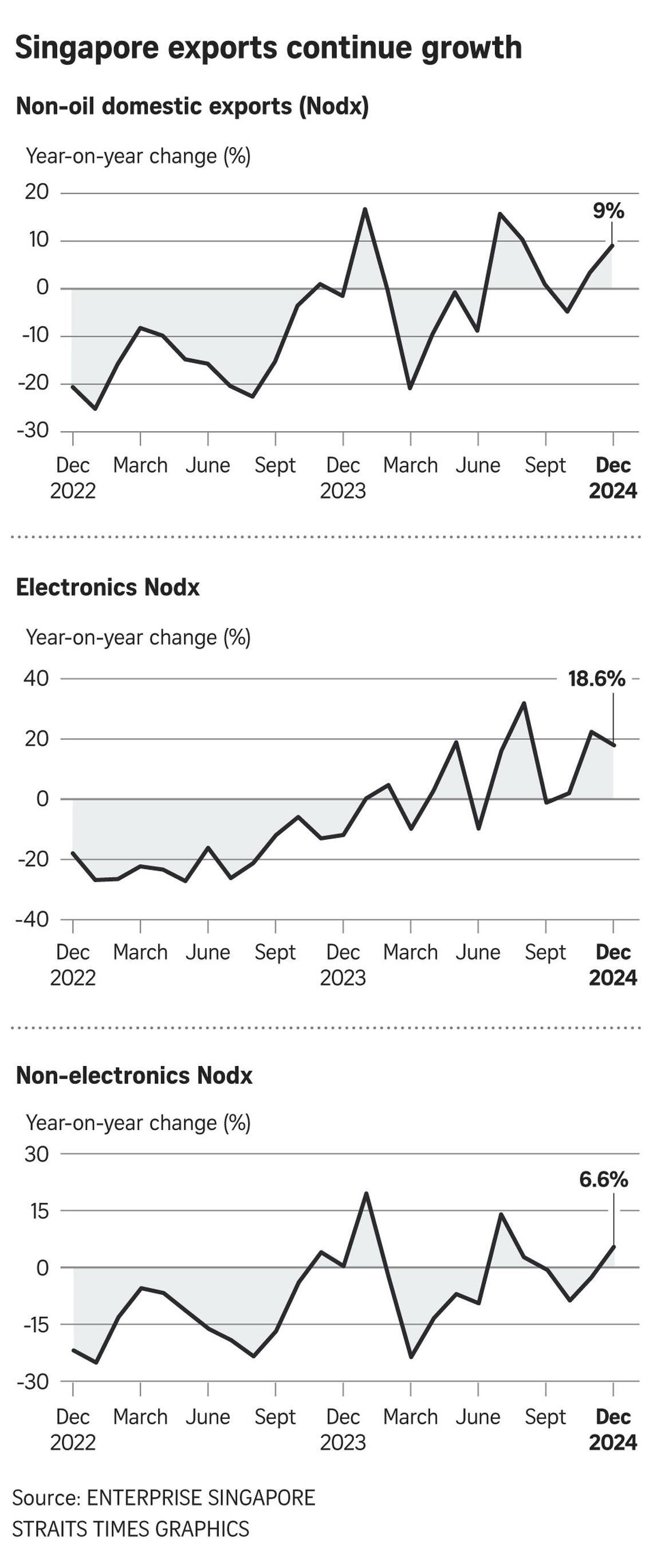Singapore’s December exports beat forecasts with 9% rise

(Photo credit: ST Photo/Gavin Foo)
Source: The Straits Times
Singapore’s key exports beat market forecasts in December 2024 in its second straight month of growth, but analysts said the road ahead is uncertain as the threat of Trump tariffs looms.
In December, non-oil domestic exports (Nodx) rose 9 per cent from a year ago, extending a 3.4 per cent increase in November, according to figures released by trade agency Enterprise Singapore on Jan 17.
Analysts polled by Bloomberg pegged growth to come in at 7.8 per cent year on year.
Month on month and seasonally adjusted, shipments rose by a smaller margin of 1.7 per cent, following a 14.7 per cent expansion in the previous month.
Maybank Investment Banking Group economists Chua Hak Bin and Brian Lee said: “Front-loading of shipments in anticipation of Trump 2.0 tariffs has been evident in the strong Nodx out-turns for November and December, particularly for electronics shipments to China, Hong Kong and Malaysia, which functions as a major hub for semiconductor assembly and testing.
“Chinese firms have been stockpiling advanced components, likely in preparation for future trade restrictions.”
Despite the export rebound in November and December, full-year 2024 Nodx growth came in below the Government’s forecast of around 1 per cent, analysts estimated.
DBS Bank economist Chua Han Teng said:
“Nodx recovered and increased by 0.2 per cent for full-year 2024, a significant improvement compared to the contraction of 13.1 per cent in 2023, despite falling slightly short of the 2024 forecast.”
OCBC Bank chief economist Selena Ling said:
“For 2025, Nodx growth may accelerate to around 2 to 4 per cent given the relatively low base in 2024 and Singapore’s free trade agreement (FTA) with the US if Trump 2.0 tariff threats materialise.”
The official estimate for 2025 Nodx growth is 1 per cent to 3 per cent.
Ms Ling said the key uncertainty is the timing and magnitude of fresh tariffs that may come into play once US President-elect Donald Trump takes office on Jan 20 and how much this may impact China and Asean economic and trade growth prospects.
“In particular, would Trump’s tariff threats kick in fairly quickly from January or later in the year, and would it be at 60 per cent for China, and 10 per cent to 20 per cent on the rest of the world or is there room for negotiation and deal-making?” she added.
There could also be indirect effects from potential trade retaliation, market sentiment and a sharper growth slowdown in China that could hurt Chinese demand for Asean’s goods and services, she said.
DBS’ Mr Chua said in the near term, Singapore’s good Nodx performance could still continue in early 2025, potentially supported by more front-loading of shipments.
“Looking beyond the near term, escalating geopolitical tensions and a potential wider trade war under a second Trump administration pose medium-term challenges and downside risks to highly trade-dependent Asian economies including Singapore,” he added.
Maybank’s Dr Chua and Mr Lee said that Singapore’s FTA and bilateral trade deficit with the US suggest that Singapore is a less likely Trump target.
But they still expect 2025 full-year export growth to weaken as global trade is hit by increased protectionism.
“Nonetheless, we expect that front-loading of shipments and shifting supply chains to South-east Asia will continue to drive manufacturing and export growth in the initial months of 2025, as Trump’s tariff threats on Chinese shipments will likely be rolled out in a phased manner,” they said.

Year on year, electronics exports expanded 18.6 per cent in December, after a 23.1 per cent rise in the previous month.
Within this segment, exports of integrated circuits, also known as chips or semiconductors, increased by 23.4 per cent. Personal computers grew 83.6 per cent, and disk media products expanded 44 per cent.
DBS’ Mr Chua said:
“Singapore’s electronics exporters continued to benefit from the global tech upcycle, and we expect continued resilient expansion to support overall Nodx growth in early 2025.”
He noted that resilient near-term external demand for Singapore’s electronics is also reflected in other indexes, such as new export orders. Demand is coming from a rising adoption of artificial intelligence applications in consumer devices amid an ongoing replacement cycle.
Non-electronic exports rose 6.6 per cent in December, reversing a 1.6 per cent decline in the previous month.
Non-monetary gold grew by 67.6 per cent, while food preparations grew by 61.5 per cent. Specialised machinery rose by 19.9 per cent.
These increases outweighed a continued weakness in volatile pharmaceuticals, Mr Chua said.
Exports to the United States, Taiwan and Malaysia went up in December but shipments to the euro zone and China declined.
Singapore’s exports to the US grew by 30.7 per cent in December, after it fell 19.4 per cent in the month before. This was mainly due to growth in non-monetary gold, food preparations and non-electric engines and motors.
Exports to Taiwan also expanded, by 50.8 per cent, due to specialised machinery, measuring instruments and PCs.
Exports to Malaysia grew by 24.2 per cent in December, due to chips, other computer peripherals and non-monetary gold.
